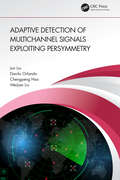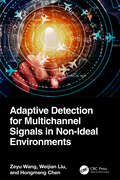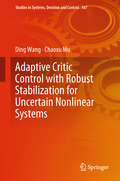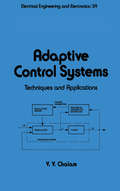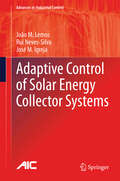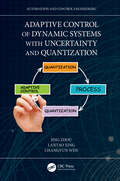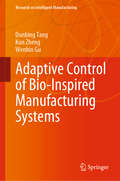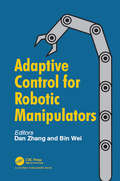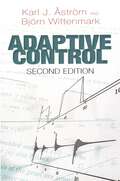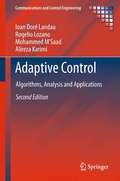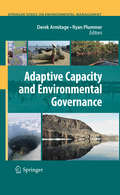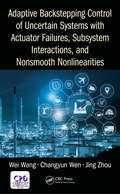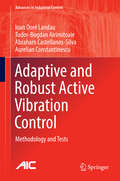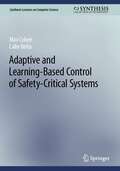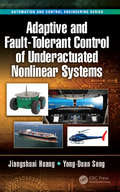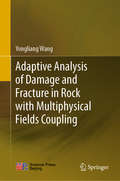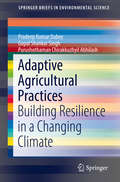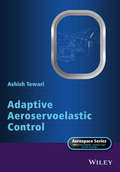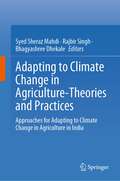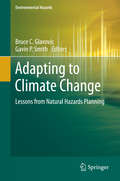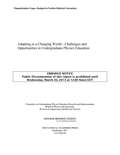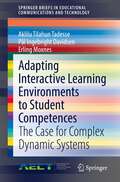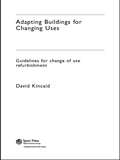- Table View
- List View
Adaptive Detection of Multichannel Signals Exploiting Persymmetry
by Jun Liu Danilo Orlando Chengpeng Hao Weijian LiuThis book offers a systematic presentation of persymmetric adaptive detection, including detector derivations and the definition of key concepts, followed by detailed discussion relating to theoretical underpinnings, design methodology, design considerations, and techniques enabling its practical implementation. The received data for modern radar systems are usually multichannel, namely, vector-valued, or even matrix-valued. Multichannel signal detection in Gaussian backgrounds is a fundamental problem for radar applications. With an overarching focus on persymmetric adaptive detectors, this book presents the mathematical models and design principles necessary for analyzing the behavior of each kind of persymmetric adaptive detector. Building upon that, it also introduces new design approaches and techniques that will guide engineering students as well as radar engineers toward efficient detector solutions, especially in challenging sample-starved environments where training data are limited. This book will be of interest to students, scholars, and engineers in the field of signal processing. It will be especially useful for those who have a solid background in statistical signal processing, multivariate statistical analysis, matrix theory, and mathematical analysis.
Adaptive Detection for Multichannel Signals in Non-Ideal Environments
by Weijian Liu Zeyu Wang Hongmeng ChenThis book systematically presents adaptive multichannel signal detection in three types of non-ideal environments, including sample-starved scenarios, signal mismatch scenarios, and noise plus subspace interference environments.The authors provide definitions of key concepts, detailed derivations of adaptive multichannel signal detectors, and specific examples for each non-ideal environment. In addition, the possible future trend of adaptive detection methods is discussed, as well as two further research points – namely, the adaptive detection algorithms based on information geometry, and the hybrid approaches that combine adaptive detection algorithms with machine learning algorithms.The book will be of interest to researchers, advanced undergraduates, and graduate students in sonar, radar signal processing, and communications engineering.
Adaptive Critic Control with Robust Stabilization for Uncertain Nonlinear Systems (Studies in Systems, Decision and Control #167)
by Ding Wang Chaoxu MuThis book reports on the latest advances in adaptive critic control with robust stabilization for uncertain nonlinear systems. Covering the core theory, novel methods, and a number of typical industrial applications related to the robust adaptive critic control field, it develops a comprehensive framework of robust adaptive strategies, including theoretical analysis, algorithm design, simulation verification, and experimental results. As such, it is of interest to university researchers, graduate students, and engineers in the fields of automation, computer science, and electrical engineering wishing to learn about the fundamental principles, methods, algorithms, and applications in the field of robust adaptive critic control. In addition, it promotes the development of robust adaptive critic control approaches, and the construction of higher-level intelligent systems.
Adaptive Control Systems: Techniques and Applications (Electrical And Computer Engineering Ser. #39)
by Chalamimpossible to access. It has been widely scattered in papers, reports, and proceedings ofsymposia, with different authors employing different symbols and terms. But now thereis a book that covers all aspects of this dynamic topic in a systematic manner.Featuring consistent terminology and compatible notation, and emphasizing unifiedstrategies, Adaptive Control Systems provides a comprehensive, integrated accountof basic concepts, analytical tools, algorithms, and a wide variety of application trendsand techniques.Adaptive Control Systems deals not only with the two principal approachesmodelreference adaptive control and self-tuning regulators-but also considers otheradaptive strategies involving variable structure systems, reduced order schemes, predictivecontrol, fuzzy logic, and more. In addition, it highlights a large number of practical applicationsin a range of fields from electrical to biomedical and aerospace engineering ...and includes coverage of industrial robots.The book identifies current trends in the development of adaptive control systems ...delineates areas for further research . : . and provides an invaluable bibliography of over1,200 references to the literature.The first authoritative reference in this important area of work, Adaptive ControlSystems is an essential information source for electrical and electronics, R&D,chemical, mechanical, aerospace, biomedical, metallurgical, marine, transportation, andpower plant engineers. It is also useful as a text in professional society seminars and inhousetraining programs for personnel involved with the control of complex systems, andfor graduate students engaged in the study of adaptive control systems.
Adaptive Control of Solar Energy Collector Systems (Advances in Industrial Control)
by Rui Neves-Silva João M. Lemos José M. IgrejaThis book describes methods for adaptive control of distributed-collector solar fields: plants that collect solar energy and deliver it in thermal form. Controller design methods are presented that can overcome difficulties found in these type of plants: they are distributed-parameter systems, i. e. , systems with dynamics that depend on space as well as time; their dynamics is nonlinear, with a bilinear structure; there is a significant level of uncertainty in plant knowledge. Adaptive methods form the focus of the text because of the degree of uncertainty in the knowledge of plant dynamics. Parts of the text are devoted to design methods that assume only a very limited knowledge about the plant. Other parts detail methods that rely on knowledge of the dominant plant structure. These methods are more plant specific, but allow the improvement of performance. Adaptive Control of Solar Energy Collector Systems demonstrates the dynamics of solar fields to be rich enough to present a challenge to the control designer while, at the same time, simple enough to allow analytic work to be done, providing case studies on dynamics and nonlinear control design in a simple and revealing, but nontrivial way. The control approaches treated in this monograph can be generalized to apply to other plants modelled by hyperbolic partial differential equations, especially process plants in which transport phenomena occur, plants like dryers, steam super-heaters and even highway traffic. An important example, used repeatedly throughout the text, is a distributed-collector solar field installed at Plataforma Solar de Almeria, located in southern Spain. The control algorithms laid out in the text are illustrated with experimental results generated from this plant. Although the primary focus of this monograph is solar energy collector, the range of other systems which can benefit from the methods described will make it of interest to control engineers working in many industries as well as to academic control researchers interested in adaptive control and its applications.
Adaptive Control of Dynamic Systems with Uncertainty and Quantization (Automation and Control Engineering)
by Jing Zhou Lantao Xing Changyun WenThis book presents a series of innovative technologies and research results on adaptive control of dynamic systems with quantization, uncertainty, and nonlinearity, including the theoretical success and practical development such as the approaches for stability analysis, the compensation of quantization, the treatment of subsystem interactions, and the improvement of system tracking and transient performance. Novel solutions by adopting backstepping design tools to a number of hotspots and challenging problems in the area of adaptive control are provided. In the first three chapters, the general design procedures and stability analysis of backstepping controllers and the basic descriptions and properties of quantizers are introduced as preliminary knowledge for this book. In the remainder of this book, adaptive control schemes are introduced to compensate for the effects of input quantization, state quantization, both input and state/output quantization for uncertain nonlinear systems and are applied to helicopter systems and DC Microgrid. Discussion remarks are provided in each chapter highlighting new approaches and contributions to emphasize the novelty of the presented design and analysis methods. Simulation results are also given in each chapter to show the effectiveness of these methods. This book is helpful to learn and understand the fundamental backstepping schemes for state feedback control and output feedback control. It can be used as a reference book or a textbook on adaptive quantized control for students with some background in feedback control systems. Researchers, graduate students, and engineers in the fields of control, information, and communication, electrical engineering, mechanical engineering, computer science, and others will benefit from this book.
Adaptive Control of Bio-Inspired Manufacturing Systems (Research on Intelligent Manufacturing)
by Dunbing Tang Kun Zheng Wenbin GuThis book introduces state-of-the-art models and methods based on the neuroendocrine-immune-inspired approaches in the field of manufacturing control systems. It develops various bio-inspired intelligent approaches for multiple applications in order to efficiently generate production plans and control solutions and agilely deal with the frequent unexpected disturbances at the shop floor level. It also provides an introduction to bio-inspired manufacturing systems with intelligent control structures and the latest technologies. Further, the book describes recent advances in the bio-inspired methodology for a high-level adaptability in manufacturing systems, including the bio-inspired control architecture and the implementation of intelligent and adaptive control approaches based on neuroendocrine-immune mechanisms and hormone-regulation principles. It offers a valuable resource for graduate students, researchers and engineers in the fields of production management, manufacturing system control and related areas.
Adaptive Control for Robotic Manipulators
by Dan Zhang Bin WeiThe robotic mechanism and its controller make a complete system. As the robotic mechanism is reconfigured, the control system has to be adapted accordingly. The need for the reconfiguration usually arises from the changing functional requirements. This book will focus on the adaptive control of robotic manipulators to address the changed conditions. The aim of the book is to summarise and introduce the state-of-the-art technologies in the field of adaptive control of robotic manipulators in order to improve the methodologies on the adaptive control of robotic manipulators. Advances made in the past decades are described in the book, including adaptive control theories and design, and application of adaptive control to robotic manipulators.
Adaptive Control: Second Edition (Dover Books on Electrical Engineering)
by Karl J. Åström Björn WittenmarkSuitable for advanced undergraduates and graduate students, this text introduces theoretical and practical aspects of adaptive control. It offers an excellent perspective on techniques as well as an active knowledge of key approaches. Readers will acquire a well-developed sense of when to use adaptive techniques and when other methods are more appropriate.Starting with a broad overview, the text explores real-time estimation, self-tuning regulators and model-reference adaptive systems, stochastic adaptive control, and automatic tuning of regulators. Additional topics include gain scheduling, robust high-gain control and self-oscillating controllers, and suggestions for implementing adaptive controllers. Concluding chapters feature a summary of applications and a brief review of additional areas closely related to adaptive control.Both authors are Professors at the Lund Institute of Technology in Sweden, and this text has evolved from their many years of research and teaching. Their insights into properties, design procedures, and implementation of adaptive controllers are complemented by the numerous examples, simulations, and problems that appear throughout the book.
Adaptive Control: Algorithms, Analysis and Applications (Communications and Control Engineering)
by Mohammed M'Saad Rogelio Lozano Ioan Doré Landau Alireza KarimiAdaptive Control (second edition) shows how a desired level of system performance can be maintained automatically and in real time, even when process or disturbance parameters are unknown and variable. It is a coherent exposition of the many aspects of this field, setting out the problems to be addressed and moving on to solutions, their practical significance and their application. Discrete-time aspects of adaptive control are emphasized to reflect the importance of digital computers in the application of the ideas presented. The second edition is thoroughly revised to throw light on recent developments in theory and applications with new chapters on: multimodel adaptive control with switching, direct and indirect adaptive regulation and adaptive feedforward disturbance compensation. Many algorithms are newly presented in MATLAB® m-file format to facilitate their employment in real systems. Classroom-tested slides for instructors to use in teaching this material are also now provided. All of this supplementary electronic material can be downloaded from fill in URL. The core material is also up-dated and re-edited to keep its perspective in line with modern ideas and more closely to associate algorithms with their applications giving the reader a solid grounding in: synthesis and analysis of parameter adaptation algorithms, recursive plant model identification in open and closed loop, robust digital control for adaptive control; * robust parameter adaptation algorithms, practical considerations and applications, including flexible transmission systems, active vibration control and broadband disturbance rejection and a supplementary introduction on hot dip galvanizing and a phosphate drying furnace. Control researchers and applied mathematicians will find Adaptive Control of significant and enduring interest and its use of example and application will appeal to practitioners working with unknown- and variable-parameter plant. Praise for the first edition: ...well written, interesting and easy to follow, so that it constitutes a valuable addition to the monographies in adaptive control for discrete-time linear systems... suitable (at least in part) for use in graduate courses in adaptive control.
Adaptive Compensation of Nonlinear Actuators for Flight Control Applications (Studies in Systems, Decision and Control #386)
by Dipankar Deb Gang Tao Jason BurkholderThis book provides a basic understanding of adaptive control and its applications in Flight control. It discusses the designing of an adaptive feedback control system and analyzes this for flight control of linear and nonlinear aircraft models using synthetic jet actuators. It also discusses control methodologies and the application of control techniques which will help practicing flight control and active flow control researchers. It also covers modelling and control designs which will also benefit researchers from the background of fluid mechanics and health management of actuation systems.The unique feature of this book is characterization of synthetic jet actuator nonlinearities over a wide range of angles of attack, an adaptive compensation scheme for such nonlinearities, and a systematic framework for feedback control of aircraft dynamics with synthetic jet actuators.
Adaptive Capacity and Environmental Governance (Springer Series on Environmental Management)
by Derek Armitage Ryan PlummerRapid environmental change calls for individuals and societies with an ability to transform our interactions with each other and the ecosystems upon which we depend. Adaptive capacity - the ability of a social-ecological system (or the components of that system) to be robust to disturbances and capable of responding to changes - is increasingly recognized as a critical attribute of multi-level environmental governance. This unique volume offers the first interdisciplinary and integrative perspective on an emerging area of applied scholarship, with contributions from internationally recognized researchers and practitioners. It demonstrates how adaptive capacity makes environmental governance possible in complex social-ecological systems. Cutting-edge theoretical developments are explored and empirical case studies offered from a wide range of geographic settings and natural resource contexts, such as water, climate, fisheries and forestry. * Of interest to researchers, policymakers and resource managers seeking to navigate and understand social-ecological change in diverse geographic settings and resource contexts
Adaptive Backstepping Control of Uncertain Systems with Actuator Failures, Subsystem Interactions, and Nonsmooth Nonlinearities
by Wei Wang Changyun Wen Jing ZhouIn practice, actuators often undergo failures and various factors influence its effectiveness. Also due to the increasing complexity of large-scale systems, subsystems are often interconnected, whereas the interactions between any two subsystems are difficult to deal with. This book details a series of new methodologies of designing and analyzing adaptive backstepping control systems involving treatment on actuator failures, subsystem interactions and nonsmooth nonlinearities. Moreover, it discusses some interesting open issues in adaptive failure accommodation, decentralized adaptive control and distributed adaptive coordinated control.
Adaptive and Robust Active Vibration Control: Methodology and Tests (Advances in Industrial Control)
by Ioan Doré Landau Tudor-Bogdan Airimițoaie Abraham Castellanos-Silva Aurelian ConstantinescuThis book approaches the design of active vibration control systems from the perspective of today s ideas of computer control. It formulates the various design problems encountered in the active management of vibration as control problems and searches for the most appropriate tools to solve them. The experimental validation of the solutions proposed on relevant tests benches is also addressed. To promote the widespread acceptance of these techniques, the presentation eliminates unnecessary theoretical developments (which can be found elsewhere) and focuses on algorithms and their use. The solutions proposed cannot be fully understood and creatively exploited without a clear understanding of the basic concepts and methods, so these are considered in depth. The focus is on enhancing motivations, algorithm presentation and experimental evaluation. MATLAB(r)routines, Simulink(r) diagrams and bench-test data are available for download and encourage easy assimilation of the experimental and exemplary material. Three major problems are addressed in the book: active damping to improve the performance of passive absorbers;adaptive feedback attenuation of single and multiple tonal vibrations; andfeedforward and feedback attenuation of broad band vibrations. Adaptive and Robust Active Vibration Control will interest practising engineers and help them to acquire new concepts and techniques with good practical validation. It can be used as the basis for a course for graduate students in mechanical, mechatronics, industrial electronics, aerospace and naval engineering. Readers working in active noise control will also discover techniques with a high degree of cross-over potential for use in their field. "
Adaptive and Learning-Based Control of Safety-Critical Systems (Synthesis Lectures on Computer Science)
by Max Cohen Calin BeltaThis book stems from the growing use of learning-based techniques, such as reinforcement learning and adaptive control, in the control of autonomous and safety-critical systems. Safety is critical to many applications, such as autonomous driving, air traffic control, and robotics. As these learning-enabled technologies become more prevalent in the control of autonomous systems, it becomes increasingly important to ensure that such systems are safe. To address these challenges, the authors provide a self-contained treatment of learning-based control techniques with rigorous guarantees of stability and safety. This book contains recent results on provably correct control techniques from specifications that go beyond safety and stability, such as temporal logic formulas. The authors bring together control theory, optimization, machine learning, and formal methods and present worked-out examples and extensive simulation examples to complement the mathematical style of presentation. Prerequisites are minimal, and the underlying ideas are accessible to readers with only a brief background in control-theoretic ideas, such as Lyapunov stability theory.
Adaptive and Fault-Tolerant Control of Underactuated Nonlinear Systems (Automation and Control Engineering)
by Jiangshuai Huang Yong-Duan SongThe purpose of the book is to provide an exposition of recently developed adaptive and fault-tolerant control of underactuated nonlinear systems. Underactuated systems are abundant in real life, ranging from landing vehicles to surface ships and underwater vehicles to spacecrafts. For the tracking and stabilization control of underactuated mechanical systems, many methodologies have been proposed. However, a number of important issues deserve further investigation. In response to these issues, four important problems are solved in this book, including control of underactuated nonlinear systems with input saturation, output-feedback control in the presence of parametric uncertainties, fault-tolerant control of underactuated ships with or without actuator redundancy, and adaptive control of multiple underactauted nonlinear systems, including formation control and flocking control of multiple underactuated systems.
Adaptive Analysis of Damage and Fracture in Rock with Multiphysical Fields Coupling
by Yongliang WangThis book mainly focuses on the adaptive analysis of damage and fracture in rock, taking into account multiphysical fields coupling (thermal, hydro, mechanical, and chemical fields). This type of coupling is a crucial aspect in practical engineering for e.g. coal mining, oil and gas exploration, and civil engineering. However, understanding the influencing mechanisms and preventing the disasters resulting from damage and fracture evolution in rocks require high-precision and reliable solutions. This book proposes adaptive numerical algorithms and simulation analysis methods that offer significant advantages in terms of accuracy and reliability. It helps readers understand these innovative methods quickly and easily. The content consists of: (1) a finite element algorithm for modeling the continuum damage evolution in rocks, (2) adaptive finite element analysis for continuum damage evolution and determining the wellbore stability of transversely isotropic rock, (3) an adaptive finite element algorithm for damage detection in non-uniform Euler–Bernoulli beams with multiple cracks, using natural frequencies, (4) adaptive finite element–discrete element analysis for determining multistage hydrofracturing in naturally fractured reservoirs, (5) adaptive finite element–discrete element analysis for multistage supercritical CO2 fracturing and microseismic modeling, and (6) an adaptive finite element–discrete element–finite volume algorithm for 3D multiscale propagation of hydraulic fracture networks, taking into account hydro-mechanical coupling. Given its scope, the book offers a valuable reference guide for researchers, postgraduates and undergraduates majoring in engineering mechanics, mining engineering, geotechnical engineering, and geological engineering.
Adaptive Agricultural Practices: Building Resilience in a Changing Climate (SpringerBriefs in Environmental Science)
by Pradeep Kumar Dubey Gopal Shankar Singh Purushothaman Chirakkuzhyil AbhilashThis brief explores several adaptive agricultural practices from around the world to fulfill current and future agricultural demands for food security due to the challenges posed by climate change and growing global population. Readers will discover how farmers adapt to environmental changes by adopting various agronomic practices at crop, farm and landscape levels. Particular attention is given to systemic and transformational adaptation strategies employed by farmers such as mulching, organic farming and crop diversification. This is a highly informative and carefully presented book that provides insights on how crops can build up resilience against periods of drought, high salinity, disasters such as floods, and diseases. The policy implications and future prospects of these adaptation strategies are also addressed. Environmental and plant scientists, agronomists and researchers in climate sciences will find this book interesting.
Adaptive Aeroservoelastic Control
by Ashish TewariThis is the first book on adaptive aeroservoelasticity and it presents the nonlinear and recursive techniques for adaptively controlling the uncertain aeroelastic dynamics Covers both linear and nonlinear control methods in a comprehensive manner Mathematical presentation of adaptive control concepts is rigorous Several novel applications of adaptive control presented here are not to be found in other literature on the topic Many realistic design examples are covered, ranging from adaptive flutter suppression of wings to the adaptive control of transonic limit-cycle oscillations
Adapting to the Land: A History of Agriculture in Colorado
by John F. FreemanAdapting to the Land examines the extent to which Colorado agriculturists adapted to or stretched beyond the limits of land and water. Historian John F. Freeman and horticultural scientist Mark E. Uchanski document the state’s agricultural history and provide context for the shift away from traditional forms of agriculture to the use of synthetic fertilizers, herbicides, and pesticides—and, most recently, to more values-driven practices to support the burgeoning popularity of natural and organic foods. This shift has resulted in the establishment of the global organic food processing and distribution industry, which has roots in Colorado. Ancestral Puebloans farmed and grazed within the limits of nature. Early settlers adjusted their cultivation methods through trial and error, while later agriculturists relied on research and technical advice from the Colorado Agricultural College. As part of wartime mobilization, the federal government prompted farmers to efficiently increase yields. To meet the demand for food and fiber scientific and technical innovations led to the development of new plant cultivars and livestock breeds, advances in mechanization, and widespread use of synthetic amendments. Increasing concern over soil fertility and the loss of irrigation water to urbanization contributed to more changes. Despite, or perhaps because of, what we see today along the Front Range, Colorado may still have a chance to slow or even reverse its seemingly unrestrained growth, creating a more vibrant, earth-friendly society in which agriculture plays an increasingly significant part. Scientific discoveries and innovations in regenerative cultivation are clearing the path to a more sustainable future. Adapting to the Land adds an ecological and horticultural perspective to historical interpretations of recurring agricultural issues in the state and tracks the concept of stewardship, suggesting that spiritual beliefs continue to contribute to debates over acceptable agricultural practices and the effects of urbanization upon the land. This book will be a key resource for students, scholars, and general readers interested in agricultural and Colorado history, sustainability, and rural sociology.
Adapting to Climate Change in Agriculture-Theories and Practices: Approaches for Adapting to Climate Change in Agriculture in India
by Syed Sheraz Mahdi Rajbir Singh Bhagyashree DhekaleThis book brings together a series of chapters that provides updated information on adaptation practices against climate change in agriculture and livestock. Information on some new aspects like conservation of carnivorous plants, climate-smart millets production, advances in genomic interventions for climate resilient crops, perceptions on disease and pests under changing climate, role of neglected crops in climate resilient agriculture, nanotechnology in sustainable agriculture, use of crop wild relatives for developing climate resilient crops have been discussed. It also presents detailed information carbon sequestration practices and green consumption behaviour for sustainable development. The last chapter of book mentions about an innovative agronomic technique under rainfed conditions for sustainable yield advantage in soybean crop.
Adapting to Climate Change: Lessons from Natural Hazards Planning (Environmental Hazards)
by Bruce C. Glavovic Gavin P. SmithThis book identifies lessons learned from natural hazard experiences to help communities plan for and adapt to climate change. Written by leading experts, the case studies examine diverse experiences, from severe storms to sea-level related hazards, droughts, heat waves, wildfires, floods, earthquakes and tsunami, in North America, Europe, Australasia, Asia, Africa and Small Island Developing States. The lessons are grouped according to four imperatives: (i) Develop collaborative governance networks; (ii) build adaptive capabilities; (iii) invest in pre-event planning; and (iv) the moral imperative to undertake adaptive actions that advance resilience and sustainability. "A theoretically rich and empirically grounded analysis of the interface between disaster risk management and climate change adaptation, comprehensive yet accessible, and very timely. " Mark Pelling, Department of Geography, King's College London, UK. "This book represents a major contribution to the understanding of natural hazards planning as an urgent first step for reducing disaster risk and adapting to climate change to ensure sustainable and equitable development. " Sálvano Briceño, Vice-Chair, Science Committee, Integrated Research on Disaster Risk IRDR, an ICSU/ISSC/ISDR programme. Former Director International Strategy for Disaster Reduction, UNISDR. "What a welcome addition to the young literature on climate adaptation and hazard mitigation! Bruc e Glavovic and Gavin Smith each bring to the editing task a rare blend of solid scholarly attainment and on-the-ground experience that shines through in this extensively-documented synthesis of theoretical ideas from the realms of climate and hazards and their validation in a rich set of diverse case studies pulled in from around the world. This book should remain a classic for many years. " William H. Hooke, American Meteorological Society.
Adapting to a Changing World--Challenges and Opportunities in Undergraduate Physics Education
by National Research Council Division on Engineering and Physical Sciences Committee on Undergraduate Physics Education Research and Implementation Board on Physics and AstronomyAdapting to a Changing World was commissioned by the National Science Foundation to examine the present status of undergraduate physics education, including the state of physics education research, and, most importantly, to develop a series of recommendations for improving physics education that draws from the knowledge we have about learning and effective teaching. Our committee has endeavored to do so, with great interest and more than a little passion. The Committee on Undergraduate Physics Education Research and Implementation was established in 2010 by the Board on Physics and Astronomy of the National Research Council. This report summarizes the committee's response to its statement of task, which requires the committee to produce a report that identifies the goals and challenges facing undergraduate physics education and identifies how best practices for undergraduate physics education can be implemented on a widespread and sustained basis, assess the status of physics education research (PER) and discuss how PER can assist in accomplishing the goal of improving undergraduate physics education best practices and education policy.
Adapting Interactive Learning Environments to Student Competences: The Case for Complex Dynamic Systems (SpringerBriefs in Educational Communications and Technology)
by Aklilu Tilahun Tadesse Pål Ingebright Davidsen Erling MoxnesThis monograph focuses on the design of personalized and adaptive online interactive learning environment (OILE) to enhance students’ learning in and about complex dynamic systems (CDS). Numerous studies show that students experience difficulties when learning in and about CDS. The difficulties are due to challenges originating from a) the structural complexity of CDS, (b) the production of dynamic behavior from the underlying systems structure, and (c) methods, techniques and tools employed in the analysis of such systems. Despite the fact that studies have uncovered such learning challenges, it is still not well understood how we may effectively address these challenges. In this monograph, the authors provide some answers as to how we may best improve our cognitive capabilities to meet these challenges by way of effective instructional methods, techniques, and tools and their implementation in the form of an OILE. The OILE developed for this purpose, builds on a five-step holistic instructional design framework; identification of instructional design models, identification of authentic learning material, identification of instructional methods, identification of instructional techniques, and design of the interface and implementation of the tool. In this OILE development, six well-documented instructional design models were considered; a four component instructional design, first principles of instruction, constructivists learning environment, task centered instruction, cognitive apprenticeship, and elaboration theory.
Adapting Buildings for Changing Uses: Guidelines for Change of Use Refurbishment
by David KincaidAdapting Building for Changing Uses discusses the comprehensive refurbishment of buildings to enable them to be used for purposes different to those originally intended.For those involved in the often risky business of conversion of buildings from one type of use to another, Adapting Building for Changing Uses provides secure guidance on which uses may be best suited to a particular location. This guidance is based on a unique decision tool, the "Use Comparator", which was developed through research carried out at UCL in the mid 1990's. The "Use Comparator" compares the physical and locational characteristics of a building with the characteristics best suited to various types of use. A total of 77 targeted types of use are evaluated, in contrast to the 17 uses normally considers by regulatory planners.Adapting Building for Changing Uses also identifies the key problems experienced by building managers involved in assembling the coalition of Producers, Investors, Marketeers, Regulators and Users, which makes the key decisions in "Adaptive Reuse". The book explores the differing perceptions and attitudes of these key decision agents to matters such as cost, value, risk and robustness, and offers advice on how to avoid the potential for project failure that these differences present.
